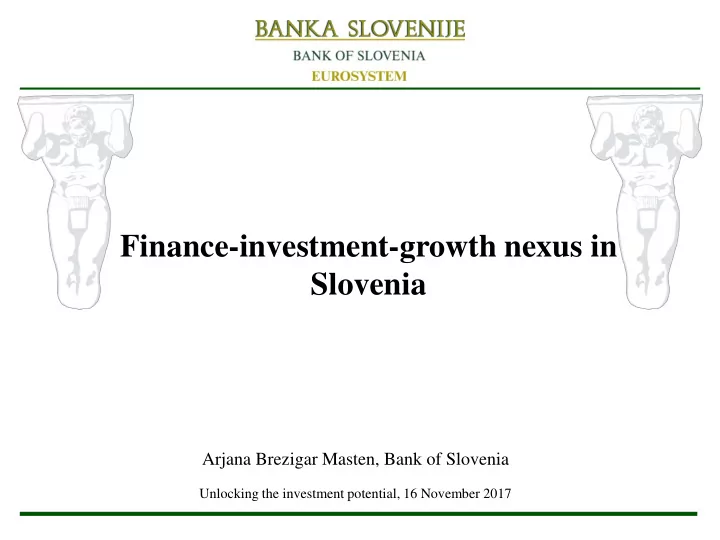

Finance-investment-growth nexus in Slovenia Arjana Brezigar Masten, Bank of Slovenia Unlocking the investment potential, 16 November 2017
Summary of main findings: • Since 2006, Slovenia experienced a boom-bust investment cycle, which led from overheating to deep recession and left the economy with a very low share of investment in GDP. • The upward part of the cycle was spurred by excessive debt financing, high confidence and profitability of the corporate sector. Excessive debt financing severely impaired NFCs' balance sheets which required substantial deleveraging and banking system recapitalization. • With debt-to-equity ratio now at 2006-2007 level, NFCs have on average decreased the level of indebtedness and are in a position to accelerate investment activity, supported by debt financing. Whether they are more resilient to potential financial shocks as they were before the crisis, should remain subject to close scrutiny. • Despite favourable economic outlook, lessons from the past crisis must not be forgotten. As the situation enables NFCs' to debt finance future growth in investment, it should be accompanied by NFCs' capital strengthening. 2
Excessive investment was a predominant factor behind overheating in 2007-2008 period and deep recession that followed. Lately, investment shows signs of recovery, but its share in GDP is low for a catching-up economy. Contributions of investment to GDP growth in Slovenia Gross fixed capital formation – international comparison in percentage points % of GDP 8 8 32 32 SK, CZ, HU 6 6 30 30 EA19 4 4 28 28 Slovenia 2 2 26 26 0 0 24 24 -2 -2 22 22 -4 -4 20 20 gross fixed capital formation -6 -6 other GDP items 18 18 -8 -8 GDP, y-o-y in % -10 -10 16 16 04 05 06 07 08 09 10 11 12 13 14 15 16 17 04 05 06 07 08 09 10 11 12 13 14 15 16 17 Source: Eurostat, Bank of Slovenia calculations. Source: SORS, Bank of Slovenia calculations. 3
Investment dynamics has been strongly influenced by a boom-bust cycle in construction. Investment in machinery and equipment has been recovering since 2015, while construction investment has been predominantly influenced by the government's ability to absorb EU funds. Sectoral contributions to nominal growth in total fixed assets – Contributions to volume growth in total fixed assets – Slovenia Slovenia in percentage points in percentage points 20 20 35 35 30 30 16 16 25 25 12 12 20 20 8 8 15 15 4 4 10 10 5 5 0 0 0 0 -4 -4 -5 -5 -8 -8 -10 -10 -12 -12 -15 -15 -20 -20 -16 -16 -25 -25 -20 -20 -30 -30 -24 -24 -35 -35 -28 -28 -40 -40 04 05 06 07 08 09 10 11 12 13 14 15 16 17 06 07 08 09 10 11 12 13 14 15 16 17 construction machinery and equipment households and NPISH general government biological resources intellectual property products financial corporations non-financial corporations total fixed assets, y-o-y in % total fixed assets, y-o-y in % Source: SORS, Bank of Slovenia calculations. Source: SORS, Bank of Slovenia calculations. 4
NFCs' investment boom-bust cycle goes in line with changes in confidence and corporate profits. With both elements becoming supportive since 2014, NFCs investment began to recover. But one major element has been missing ... Operating profit of non-financial corporations Economic sentiment indicator seasonally adjusted data, long-term average = 100 EUR billions 4.0 130 130 3.5 120 120 3.0 110 110 2.5 100 100 2.0 90 90 1.5 80 80 1.0 Slovenia 0.5 70 70 EA19 0.0 60 60 05 06 07 08 09 10 11 12 13 14 15 16 05 06 07 08 09 10 11 12 13 14 15 16 17 Source: AJPES, Bank of Slovenia calculations. Note: NFCs excluding SPs. Source: European Commission. 5
... bank credit! Prior to the crisis, investment boom was spurred by excessive debt financing, which severely impaired NFCs' balance sheets. In 2012, strong deleveraging process started which has now brought NFCs in shape for acceleration in investment activity, supported by debt financing. Comparison of NFCs debt* to equity ratio between Slovenia and euro area % 150 150 SI EA19 140 140 130 130 120 120 110 110 100 100 90 90 80 80 * Securities other than shares, loans and other accounts payable. 70 70 06 07 08 09 10 11 12 13 14 15 16 17 Sorce: ECB, Eurostat, Bank of Slovenia calculations . 6
Summary of main findings: • Since 2006, Slovenia experienced a boom-bust investment cycle, which led from overheating to deep recession and left the economy with a very low share of investment in GDP. • The upward part of the cycle was spurred by excessive debt financing, high confidence and profitability of the corporate sector. Excessive debt financing severely impaired NFCs' balance sheets which required substantial deleveraging and banking system recapitalization. • With debt-to-equity ratio now at 2006-2007 level, NFCs have on average decreased the level of indebtedness and are in a position to accelerate investment activity, supported by debt financing. Whether they are more resilient to potential financial shocks as they were before the crisis, should remain subject to close scrutiny. • Despite favourable economic outlook, lessons from the past crisis must not be forgotten. As the situation enables NFCs' to debt finance future growth in investment, it should be accompanied by NFCs' capital strengthening. 7
Recommend
More recommend